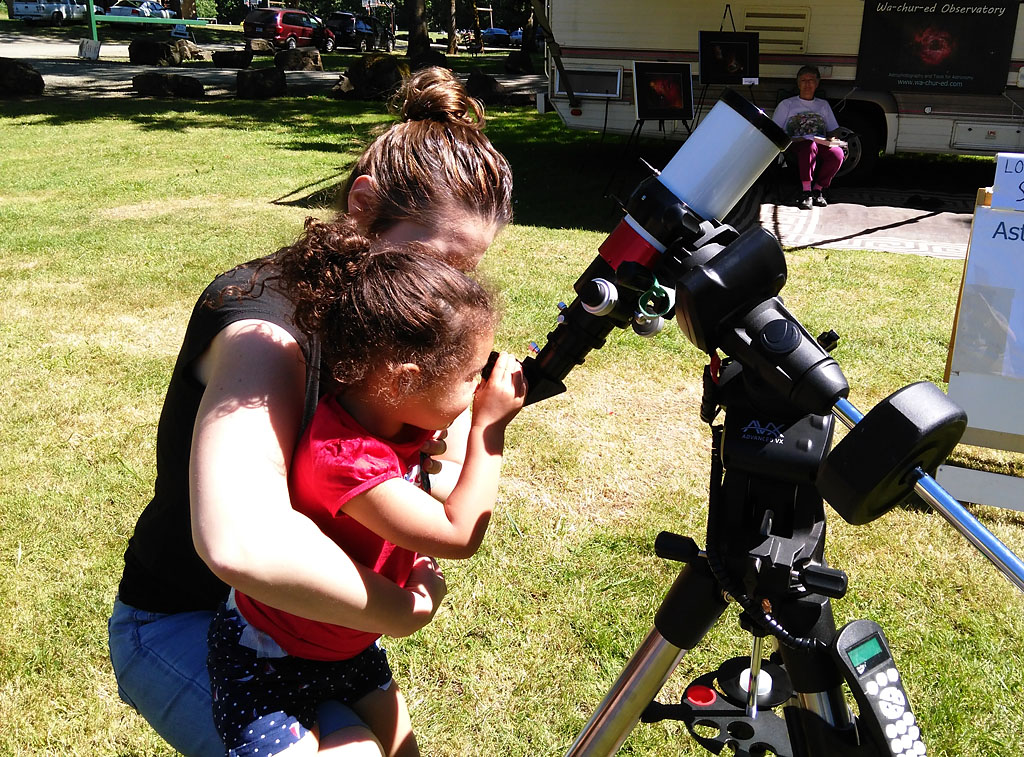One of the greatest things about astronomy is that when we look at very distant objects in the universe we are actually looking back in time. Because it takes time for light (and other “signals”) to reach us over huge distances, we can literally see what things were like long ago. Thus, the science of astronomy is largely about history. The difference between astronomers and historians is that astronomers have to use a lot of tricky extrapolation and inference to learn about the past.
I, on the other hand, can tell you about the recent past of Wa-chur-ed Observatory directly from memory – and a quick look at the books! There were several events this year that were “first light” for me, including NEAF, the Table Mountain Star Party, Pioneer Days in Brownsville, OR, the solar eclipse (!), the art show in Lake Oswego, and so on. Behind the scenes, I was very busy developing PerfectStar B, and doing more outreach events than usual. Perhaps as a result of this, I didn’t put as much effort into promotion, and total sales grew only very slightly over the previous year. Of course, the previous year was exceptional, so in the long run, I still have a pretty good record of growth.
2018 looks very promising, starting with the Air & Space Magazine photo contest. Did you vote for the Readers’ Choice award? Voting closed last night, so it’s too late now. In truth, I think it’s very unlikely that I’ll win that award, since most of the readers seem to be more interested in aircraft than in Space. But maybe we will take 1st place in the astronomy category.
I’m thinking about attending NEAF as a vendor this year, but haven’t worked out the details yet. The main purpose of that would be to show my backlit print technology to the astro-photography community, but I would also show PerfectStar and “Mister T”, of course.
To kick off the year for astro-photography, there will be a total Lunar Eclipse the morning of Jan. 31st. Totality will be at 5:30AM here on the west coast, so we will (theoretically) get to see the whole first half, but the Sun will come up before it’s over. The bigger question is whether the sky will be clear enough to see the eclipse!
This should be a good year for viewing and photographing the planets. Jupiter will be at opposition (closest to Earth) on May 15, Saturn on June 27. and Mars on July 26. The Perseids Meteor Shower will be very close to the New Moon this year on Aug. 12, so that should also be a good opportunity. Except for the Taurids in November, the other major meteor showers will be under marginal to poor viewing conditions with regard to the lunar cycle.
That lunar eclipse on January 31 is also the 2nd Full Moon in January – what is commonly (although somewhat erroneously) referred to as a “blue moon”. February then has NO full moon, and March again has 2!
The Table Mountain Star Party coincides with the Oregon Star Party this year, so I will be at OSP in mid-August. I haven’t been able to do any imaging for many weeks now – mostly because of cloud cover, so thinking about OSP in August is like a dream. I’m really looking forward to working with my new ‘scope, the William Optics FLT-132. I also hope to “double stack” my solar ‘scope and do more solar imaging this year.
I hope you have a great 2018. If you “keep looking up” it should be very enjoyable – at least astronomically!
